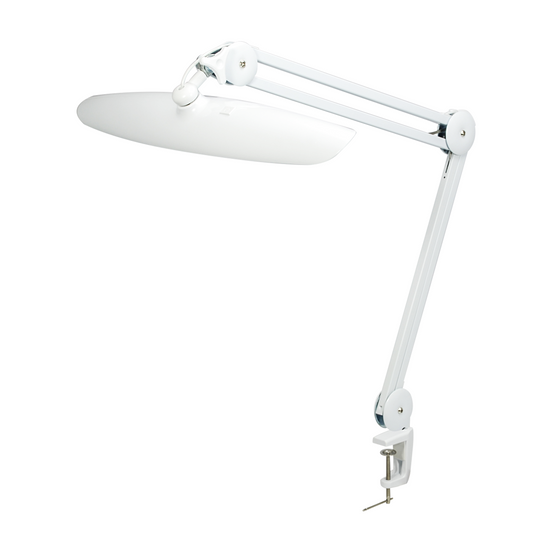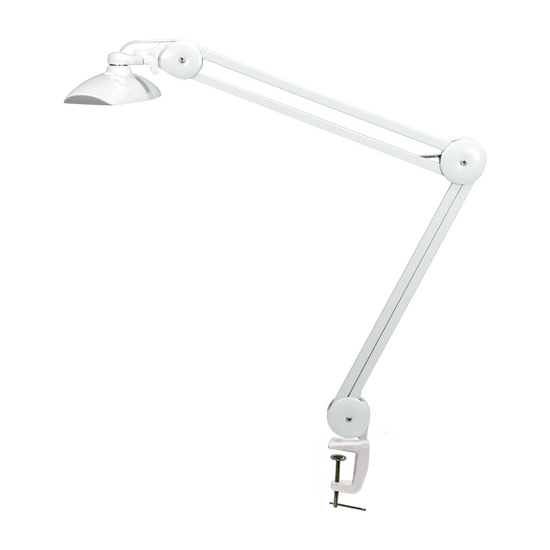Instruction Manual
ML16221121 Working Lamp Instruction Manual-English.pdf
Quick Overview
Flexible Arm. Horizontal Arm Length: 410mm. Total Arm Length: 820mm. Mounting Hole on the End of Horizontal Arm: Dia. 12.2mm. Clamp Opening Size: 0-60mm, 2.36 inches . LED Light. LED Quantity: 182. Light Adjustable. Output Power: 20W. Input Voltage: AC 100-240V 50/60Hz. Power Cord Connector Type: USA 2 Pins. Head Material: Heavy Duty Plastic. Head Appearance: Rectangle. Swing Arm Material: Heavy Duty Metal.
ML16221121 Working Lamp Instruction Manual-English.pdf
Quick Overview
Flexible Arm. Horizontal Arm Length: 410mm. Total Arm Length: 820mm. Mounting Hole on the End of Horizontal Arm: Dia. 12.2mm. Clamp Opening Size: 0-60mm, 2.36 inches . LED Light. LED Quantity: 182. Light Adjustable. Output Power: 20W. Input Voltage: AC 100-240V 50/60Hz. Power Cord Connector Type: USA 2 Pins. Head Material: Heavy Duty Plastic. Head Appearance: Rectangle. Swing Arm Material: Heavy Duty Metal.
ML16221121 Color Temperature Adjustable Working Lamp
Working Lamp
| Stand Type | Flexible Arm |
| Stand Height | 820mm |
| Horizontal Arm Length | 410mm |
| Total Arm Length | 820mm |
| Mounting Hole on the End of Horizontal Arm | Dia. 12.2mm |
| Base Type | Metal Clamp |
| Clamp Opening Size | 0-60mm, 2.36 inches |
| Light Source Type | LED Light |
| LED Quantity | 182 |
| Power Supply Adjustable | Light Adjustable |
| Light Source Luminous Flux | 2000 LM |
| Bulb Color Temperature | 3000K/4500K/6000K |
| Head Material | Heavy Duty Plastic |
| Head Appearance | Rectangle |
| Swing Arm Material | Heavy Duty Metal |
| Clamp Material | Heavy Duty Metal |
| Color | White |
| Net Weight | 2.10kg (4.63lbs) |
Power Supply
| Output Power | 20W |
| Input Voltage | AC 100-240V 50/60Hz |
| Power Cord Connector Type | USA 2 Pins |
| Power Cable Length | 1.3m |
Environment Requirement
| Operating Temperature | -5~40°C(23~104°F) |
| Operating Humidity | 95% |
Technical Info
Instructions
IlluminatorClose Λ
| The conditions of different illumination of the microscope are a very important parameter. Choosing the correct illumination method can improve the resolution and contrast of the image, which is very important for observing the imaging of different objects. The wavelength of the light source is the most important factor affecting the resolution of the microscope. The wavelength of the light source must be smaller than the distance between the two points to be observed in order to be distinguished by the human eye. The resolution of the microscope is inversely proportional to the wavelength of the light source. Within the range of the visible light, the violet wavelength is the shortest, providing also the highest resolution. The wavelength of visible light is between 380~780nm, the maximum multiple of optical magnification is 1000-2000X, and the limit resolution of optical microscope is about 200nms. In order to be able to observe a much smaller object and increase the resolution of the microscope, it is necessary to use light having a much shorter wavelength as the light source. The most commonly used technical parameters for describing illumination are luminescence intensity and color temperature. Luminescence intensity, with lumen as unit, is the physical unit of luminous flux. The more lumens, the stronger the illumination. Color temperature, with K (Kelvin) as unit, is a unit of measure indicating the color component of the light. The color temperature of red is the lowest, then orange, yellow, white, and blue, all gradually increased, with the color temperature of blue being the highest. The light color of the incandescent lamp is warm white, its color temperature is 2700K, the color temperature of the halogen lamp is about 3000K, and the color temperature of the daylight fluorescent lamp is 6000K. A complex and complete lighting system can include a light source, a lampshade or lamp compartment, a condenser lens, a diaphragm, a variety of wavelength filters, a heat sink cooling system, a power supply, and a dimming device etc. Select and use different parts as needed. Of which, selection and use of the illuminating light source is the most important part of the microscope illumination system, as and other components are designed around the illuminating wavelength curve and characteristics of the illuminating light source. Some of the microscope light sources are pre-installed on the body or frame of the microscope, and some are independent. There are many types and shapes of light sources. Depending on the requirements of the microscope and the object to be observed, one type or multiple types of illumination at the same time can be selected. In addition, the whole beam and band adjustment of the light source, the position and illumination angle of the light source, and the intensity and brightness of the light all have a great influence on the imaging. For microscope imaging, a good lighting system may be a system that allows for more freedom of adjustment. In actual work, such as industry, too many adjustment mechanisms may affect the efficiency of use, therefore choose the appropriated configured lighting conditions is very important. |
Light AdjustableClose Λ
| The brightness of the light source adjustable is very important in the imaging of the microscope. Since the difference of the numerical aperture of the objective lens of high magnification and low magnification is very big, more incident light is needed to achieve a much better resolution when using a high magnification objective lens. Therefore, when observing through a high magnification objective lens, the brightness required is high; when observing through a low magnification objective lens, the brightness required is low. When observing different objects, or feature points of the same object at different positions, the brightness needs are also different; including the difference of background light or reflection within the field of view of observation, it has a great influence on the effect of observing the object, and therefore one needs to adjust the brightness of the light source according to each object to be observed. In the light source capable of providing continuous spectrum, such as a halogen lamp, the brightness adjustment of the light not only adjusts the brightness and intensity of the light, but also changes the spectrum emitted by the light source. When the light source is dark, there are many components of red light, and when the brightness is high, there are more blue spectrum. If the required light is strong and the spectrum needs to be changed, the light can be kept at a brighter intensity, which is solved by adjusting the spectrum by adding a color filter. Take note of the dimming button on the light source, after the On/Off switch is turned on, normally clockwise is to brighten, and counterclockwise is to darken. If it is adjusted to the lowest brightness, the light source should normally be lit. If the naked eye still can't see the object being illuminated brightly, you need to adjust the brightness knob to a much bigger position. Generally, there is scale marking on the dimming knob, which is an imaginary number representing the percentage of brightness, or an electronic digital display, giving the brightness of the light source under the same conditions a marking. |
PackagingClose Λ
| After unpacking, carefully inspect the various random accessories and parts in the package to avoid omissions. In order to save space and ensure safety of components, some components will be placed outside the inner packaging box, so be careful of their inspection. For special packaging, it is generally after opening the box, all packaging boxes, protective foam, plastic bags should be kept for a period of time. If there is a problem during the return period, you can return or exchange the original. After the return period (usually 10-30 days, according to the manufacturer’s Instruction of Terms of Service), these packaging boxes may be disposed of if there is no problem. |
| Packing | |
| Packaging Type | Carton Packaging |
| Packaging Material | Corrugated Carton |
| Packaging Dimensions(1) | 68x21x13cm (26.772x8.268x5.811″) |
| Inner Packing Material | Plastic Bag |
| Ancillary Packaging Materials | Expanded Polystyrene |
| Gross Weight | 2.73kg (6.02lbs) |
| Minimum Packaging Quantity | 1pc |
| Transportation Carton | Carton Packaging |
| Transportation Carton Material | Corrugated Carton |
| Transportation Carton Dimensions(1) | 68x21x13cm (26.772x8.268x5.811″) |
| Total Gross Weight of Transportation(kilogram) | 2.73 |
| Total Gross Weight of Transportation(pound) | 6.02 |
| Quantity of One Transportation Carton | 1pc |

















